Page 53 of 558
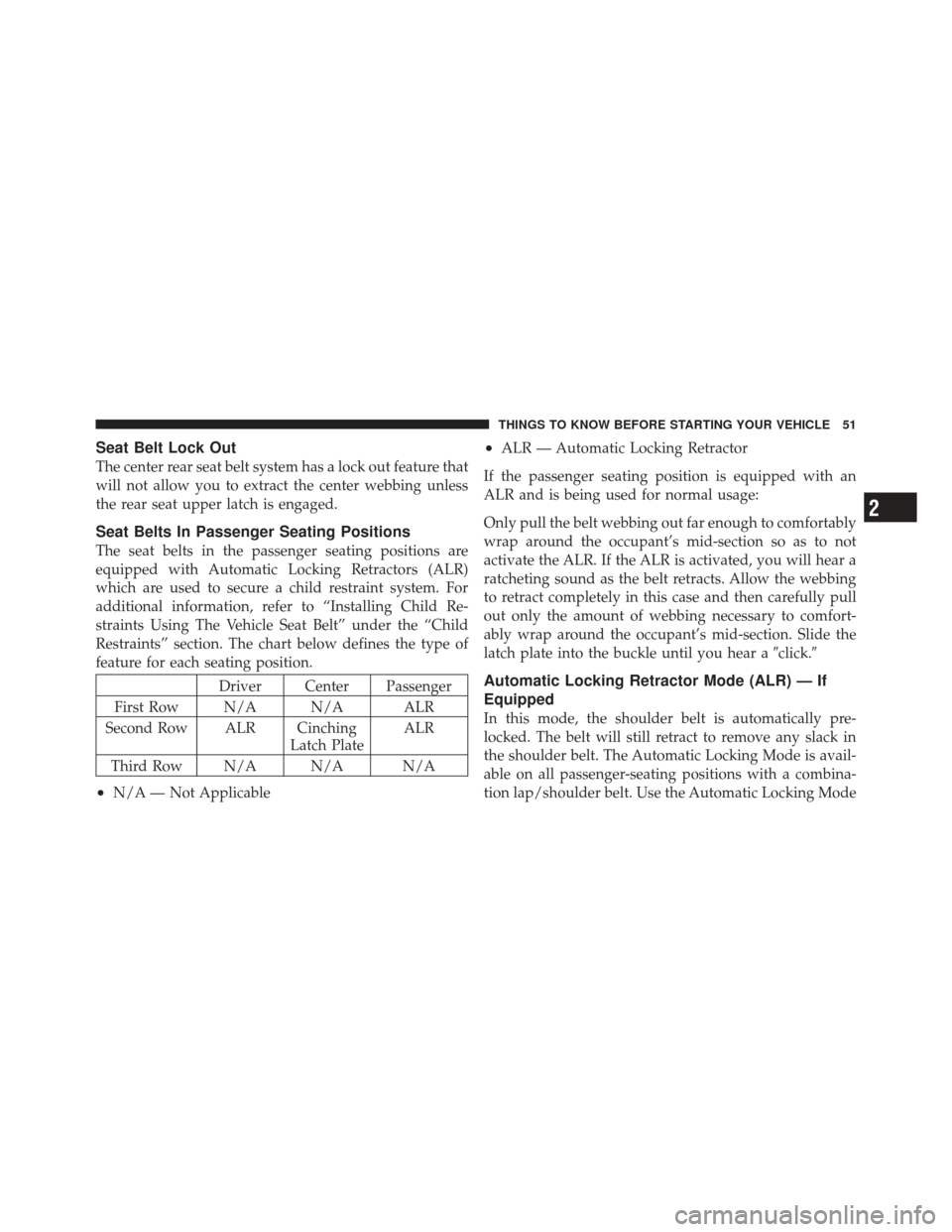
Seat Belt Lock Out
The center rear seat belt system has a lock out feature that
will not allow you to extract the center webbing unless
the rear seat upper latch is engaged.
Seat Belts In Passenger Seating Positions
The seat belts in the passenger seating positions are
equipped with Automatic Locking Retractors (ALR)
which are used to secure a child restraint system. For
additional information, refer to “Installing Child Re-
straints Using The Vehicle Seat Belt” under the “Child
Restraints” section. The chart below defines the type of
feature for each seating position.
Driver Center Passenger
First Row N/A N/A ALR
Second Row ALR Cinching Latch PlateALR
Third Row N/A N/A N/A
•N/A — Not Applicable
•ALR — Automatic Locking Retractor
If the passenger seating position is equipped with an
ALR and is being used for normal usage:
Only pull the belt webbing out far enough to comfortably
wrap around the occupant’s mid-section so as to not
activate the ALR. If the ALR is activated, you will hear a
ratcheting sound as the belt retracts. Allow the webbing
to retract completely in this case and then carefully pull
out only the amount of webbing necessary to comfort-
ably wrap around the occupant’s mid-section. Slide the
latch plate into the buckle until you hear a �click.�
Automatic Locking Retractor Mode (ALR) — If
Equipped
In this mode, the shoulder belt is automatically pre-
locked. The belt will still retract to remove any slack in
the shoulder belt. The Automatic Locking Mode is avail-
able on all passenger-seating positions with a combina-
tion lap/shoulder belt. Use the Automatic Locking Mode
2
THINGS TO KNOW BEFORE STARTING YOUR VEHICLE 51
Page 54 of 558
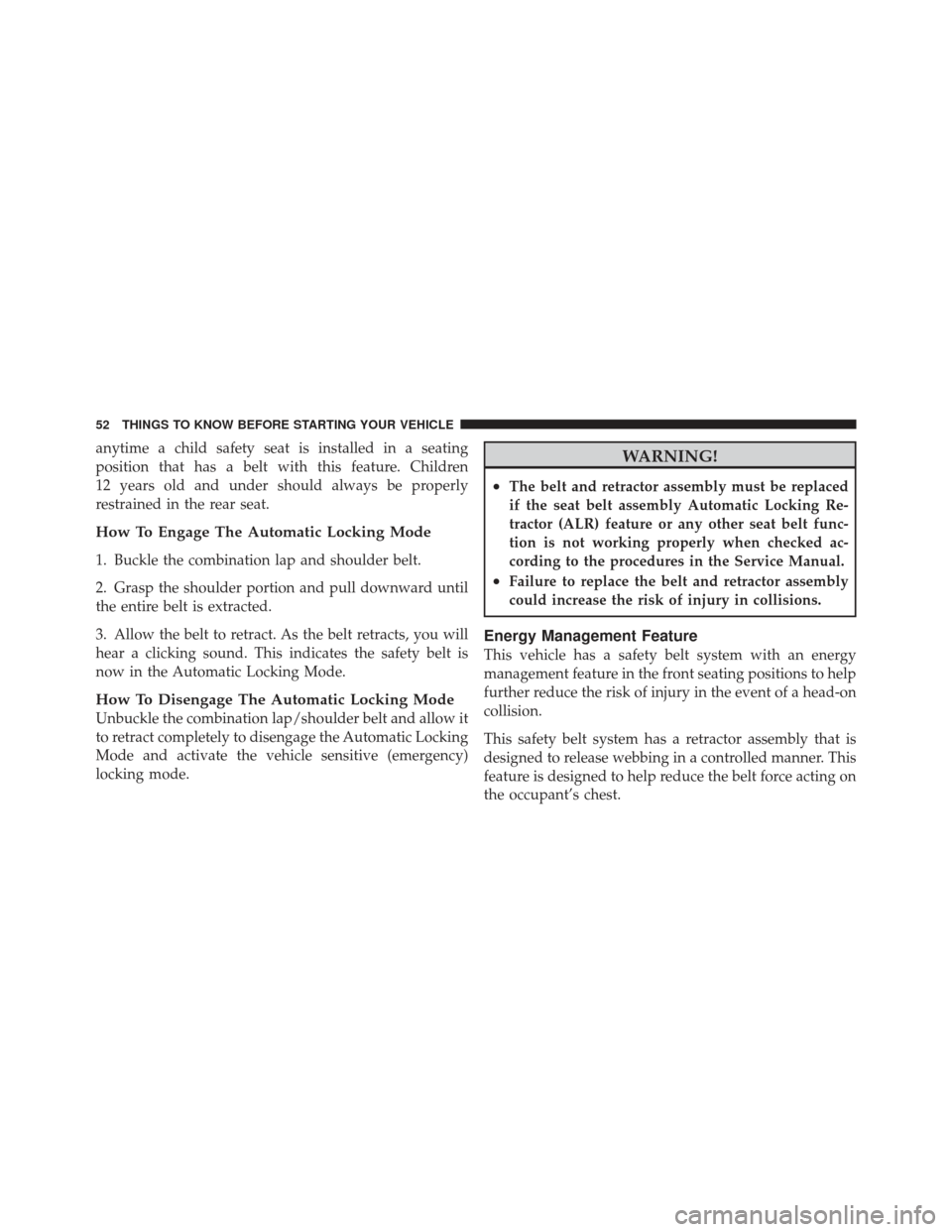
anytime a child safety seat is installed in a seating
position that has a belt with this feature. Children
12 years old and under should always be properly
restrained in the rear seat.
How To Engage The Automatic Locking Mode
1. Buckle the combination lap and shoulder belt.
2. Grasp the shoulder portion and pull downward until
the entire belt is extracted.
3. Allow the belt to retract. As the belt retracts, you will
hear a clicking sound. This indicates the safety belt is
now in the Automatic Locking Mode.
How To Disengage The Automatic Locking Mode
Unbuckle the combination lap/shoulder belt and allow it
to retract completely to disengage the Automatic Locking
Mode and activate the vehicle sensitive (emergency)
locking mode.
WARNING!
•The belt and retractor assembly must be replaced
if the seat belt assembly Automatic Locking Re-
tractor (ALR) feature or any other seat belt func-
tion is not working properly when checked ac-
cording to the procedures in the Service Manual.
•Failure to replace the belt and retractor assembly
could increase the risk of injury in collisions.
Energy Management Feature
This vehicle has a safety belt system with an energy
management feature in the front seating positions to help
further reduce the risk of injury in the event of a head-on
collision.
This safety belt system has a retractor assembly that is
designed to release webbing in a controlled manner. This
feature is designed to help reduce the belt force acting on
the occupant’s chest.
52 THINGS TO KNOW BEFORE STARTING YOUR VEHICLE
Page 55 of 558
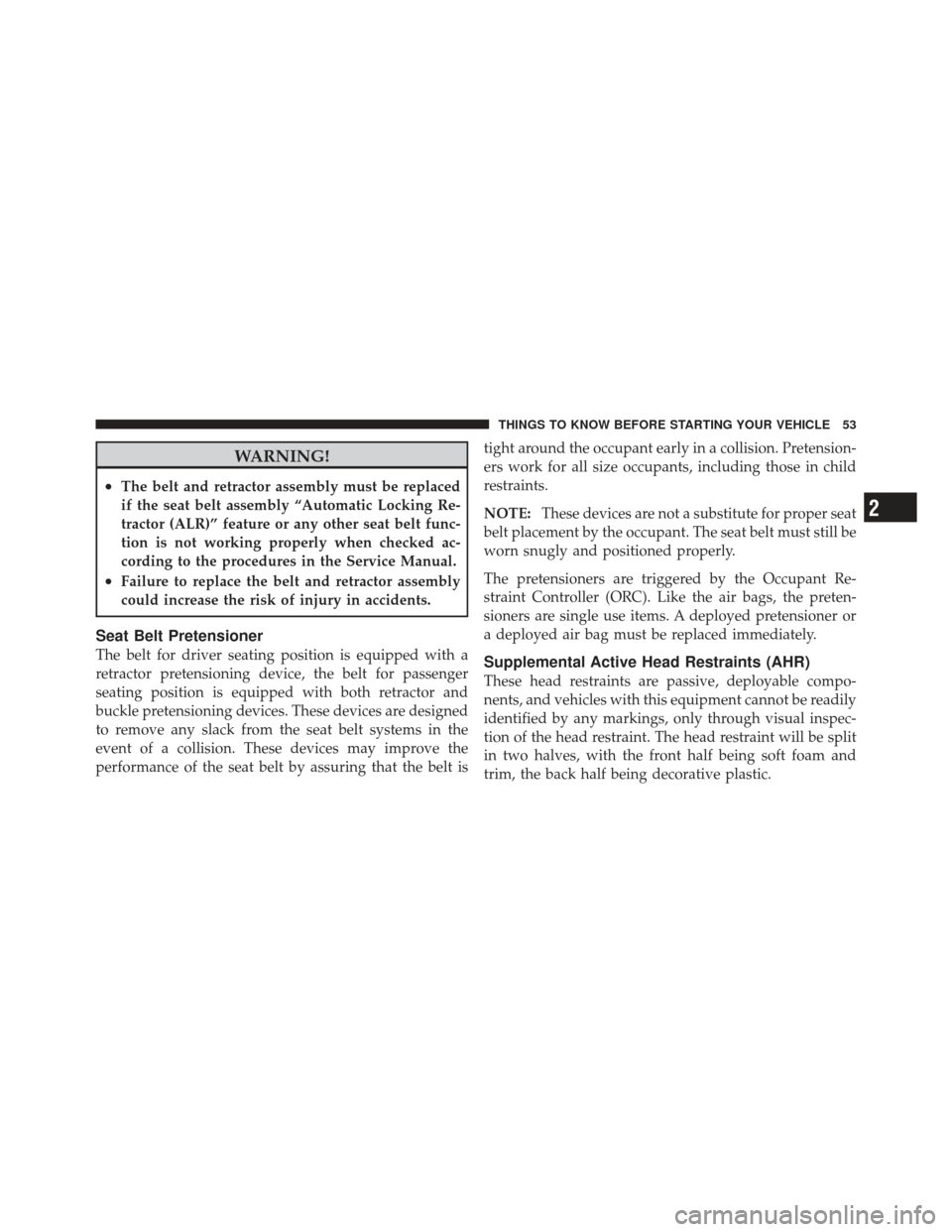
WARNING!
•The belt and retractor assembly must be replaced
if the seat belt assembly “Automatic Locking Re-
tractor (ALR)” feature or any other seat belt func-
tion is not working properly when checked ac-
cording to the procedures in the Service Manual.
•Failure to replace the belt and retractor assembly
could increase the risk of injury in accidents.
Seat Belt Pretensioner
The belt for driver seating position is equipped with a
retractor pretensioning device, the belt for passenger
seating position is equipped with both retractor and
buckle pretensioning devices. These devices are designed
to remove any slack from the seat belt systems in the
event of a collision. These devices may improve the
performance of the seat belt by assuring that the belt istight around the occupant early in a collision. Pretension-
ers work for all size occupants, including those in child
restraints.
NOTE:
These devices are not a substitute for proper seat
belt placement by the occupant. The seat belt must still be
worn snugly and positioned properly.
The pretensioners are triggered by the Occupant Re-
straint Controller (ORC). Like the air bags, the preten-
sioners are single use items. A deployed pretensioner or
a deployed air bag must be replaced immediately.Supplemental Active Head Restraints (AHR)
These head restraints are passive, deployable compo-
nents, and vehicles with this equipment cannot be readily
identified by any markings, only through visual inspec-
tion of the head restraint. The head restraint will be split
in two halves, with the front half being soft foam and
trim, the back half being decorative plastic.
2
THINGS TO KNOW BEFORE STARTING YOUR VEHICLE 53
Page 58 of 558
3. Pulldownthenrearward towards the rear of the
vehicle then downto engage the locking mechanism.
4. The AHR front soft foam and trim half should lock
into the back decorative plastic half.
1 — Downward Movement
2 — Rearward Movement
3—Final Downward Movement To Engage Locking Mechanism
56 THINGS TO KNOW BEFORE STARTING YOUR VEHICLE
Page 66 of 558
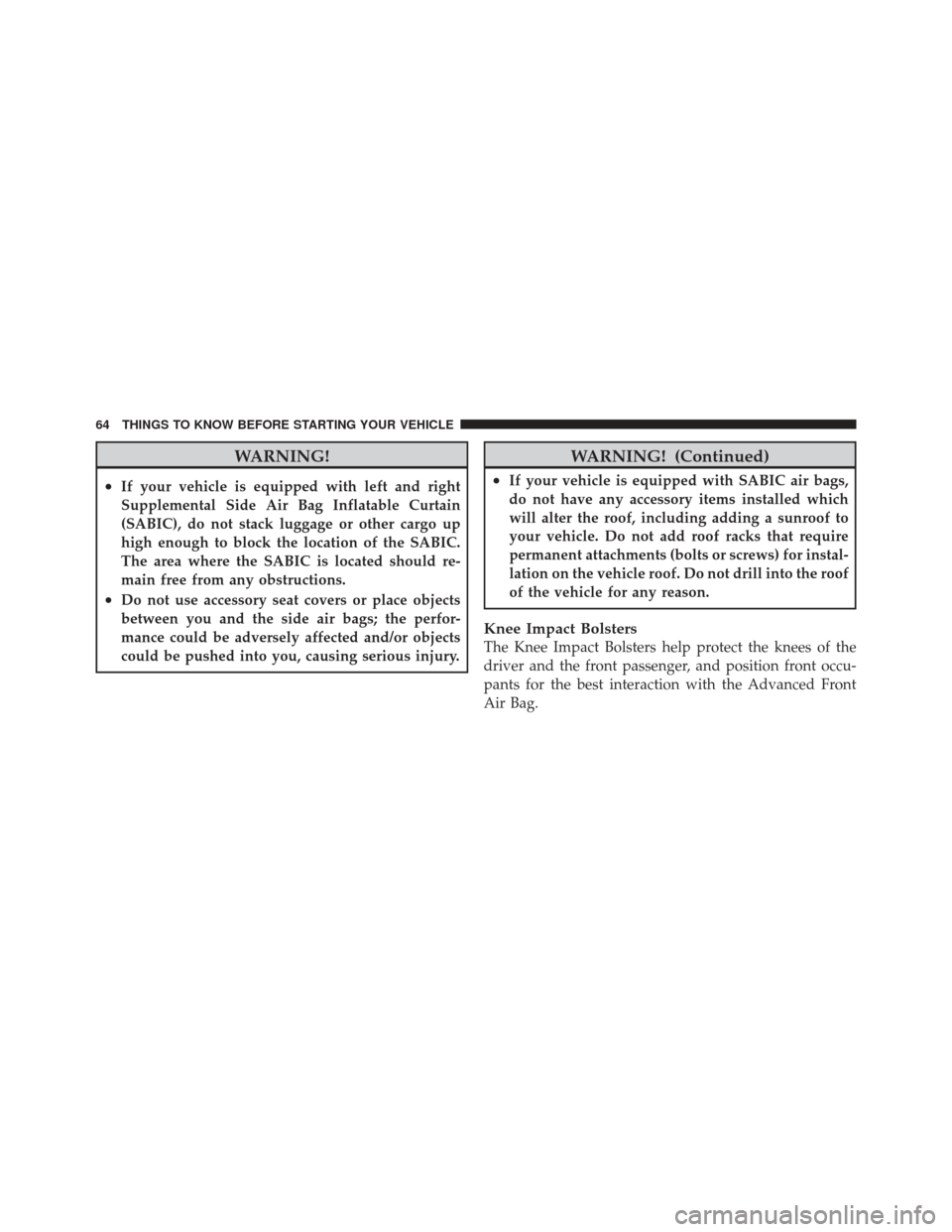
WARNING!
•If your vehicle is equipped with left and right
Supplemental Side Air Bag Inflatable Curtain
(SABIC), do not stack luggage or other cargo up
high enough to block the location of the SABIC.
The area where the SABIC is located should re-
main free from any obstructions.
•Do not use accessory seat covers or place objects
between you and the side air bags; the perfor-
mance could be adversely affected and/or objects
could be pushed into you, causing serious injury.
WARNING! (Continued)
•If your vehicle is equipped with SABIC air bags,
do not have any accessory items installed which
will alter the roof, including adding a sunroof to
your vehicle. Do not add roof racks that require
permanent attachments (bolts or screws) for instal-
lation on the vehicle roof. Do not drill into the roof
of the vehicle for any reason.
Knee Impact Bolsters
The Knee Impact Bolsters help protect the knees of the
driver and the front passenger, and position front occu-
pants for the best interaction with the Advanced Front
Air Bag.
64 THINGS TO KNOW BEFORE STARTING YOUR VEHICLE
Page 68 of 558
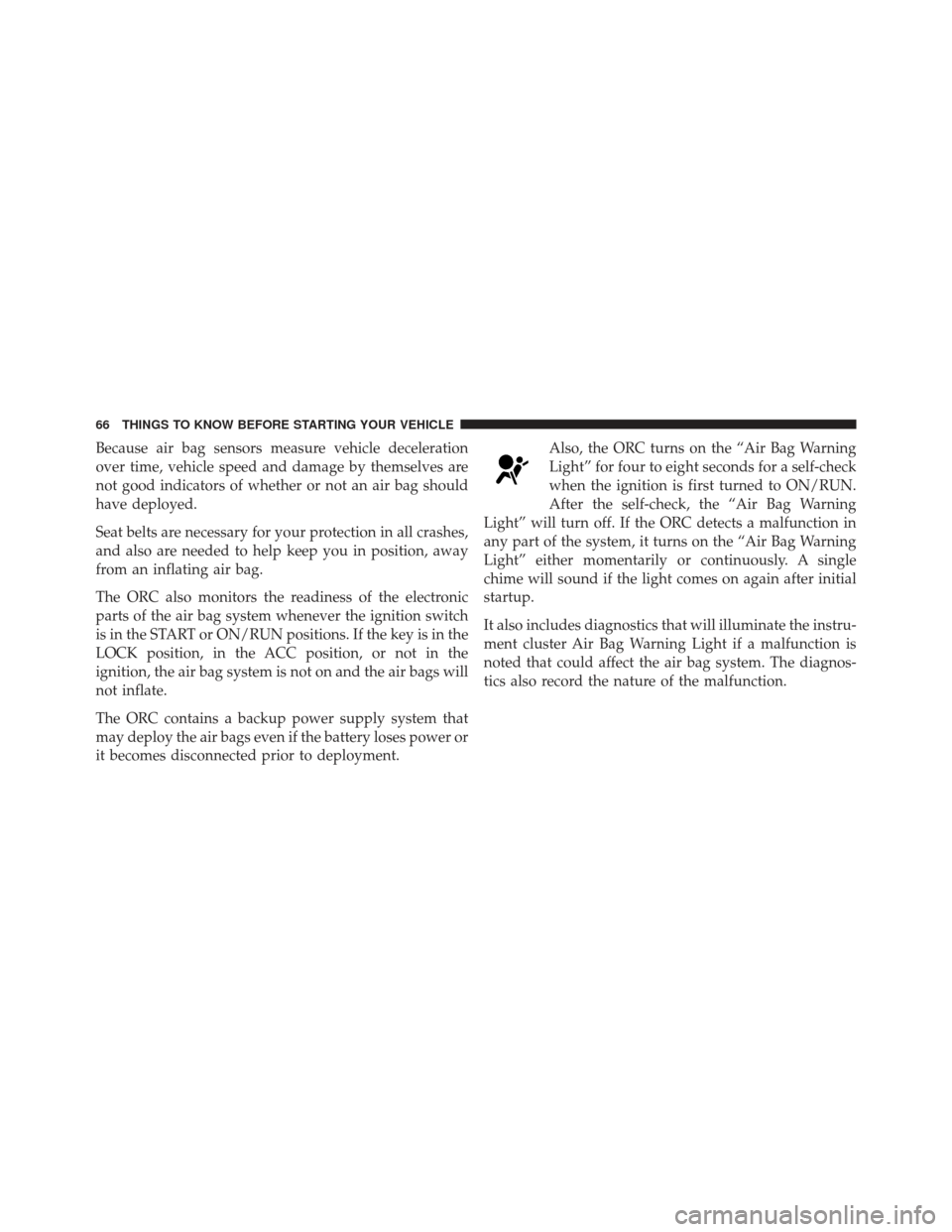
Because air bag sensors measure vehicle deceleration
over time, vehicle speed and damage by themselves are
not good indicators of whether or not an air bag should
have deployed.
Seat belts are necessary for your protection in all crashes,
and also are needed to help keep you in position, away
from an inflating air bag.
The ORC also monitors the readiness of the electronic
parts of the air bag system whenever the ignition switch
is in the START or ON/RUN positions. If the key is in the
LOCK position, in the ACC position, or not in the
ignition, the air bag system is not on and the air bags will
not inflate.
The ORC contains a backup power supply system that
may deploy the air bags even if the battery loses power or
it becomes disconnected prior to deployment.Also, the ORC turns on the “Air Bag Warning
Light” for four to eight seconds for a self-check
when the ignition is first turned to ON/RUN.
After the self-check, the “Air Bag Warning
Light” will turn off. If the ORC detects a malfunction in
any part of the system, it turns on the “Air Bag Warning
Light” either momentarily or continuously. A single
chime will sound if the light comes on again after initial
startup.
It also includes diagnostics that will illuminate the instru-
ment cluster Air Bag Warning Light if a malfunction is
noted that could affect the air bag system. The diagnos-
tics also record the nature of the malfunction.
66 THINGS TO KNOW BEFORE STARTING YOUR VEHICLE
Page 74 of 558
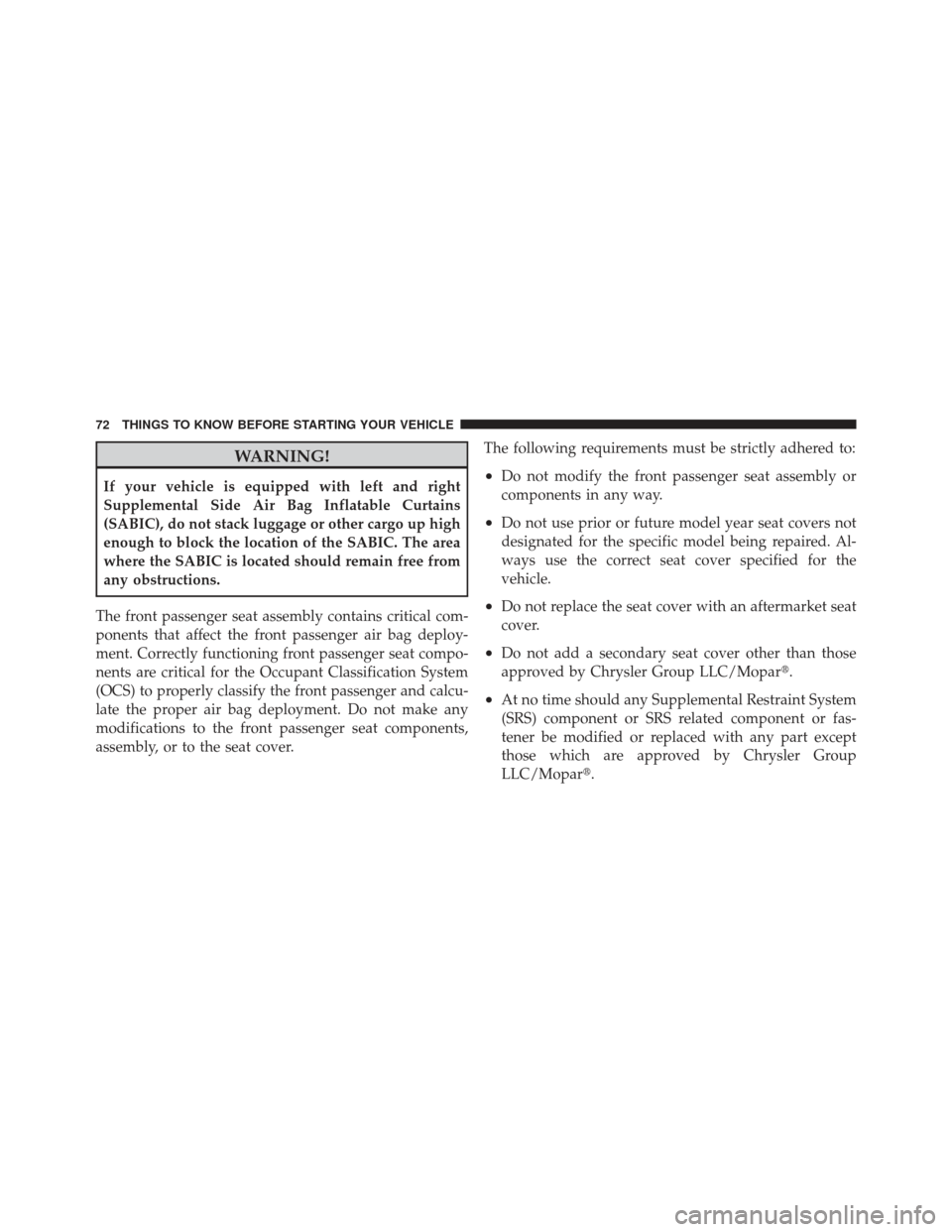
WARNING!
If your vehicle is equipped with left and right
Supplemental Side Air Bag Inflatable Curtains
(SABIC), do not stack luggage or other cargo up high
enough to block the location of the SABIC. The area
where the SABIC is located should remain free from
any obstructions.
The front passenger seat assembly contains critical com-
ponents that affect the front passenger air bag deploy-
ment. Correctly functioning front passenger seat compo-
nents are critical for the Occupant Classification System
(OCS) to properly classify the front passenger and calcu-
late the proper air bag deployment. Do not make any
modifications to the front passenger seat components,
assembly, or to the seat cover. The following requirements must be strictly adhered to:•Do not modify the front passenger seat assembly or
components in any way.
•Do not use prior or future model year seat covers not
designated for the specific model being repaired. Al-
ways use the correct seat cover specified for the
vehicle.
•Do not replace the seat cover with an aftermarket seat
cover.
•Do not add a secondary seat cover other than those
approved by Chrysler Group LLC/Mopar�.
•At no time should any Supplemental Restraint System
(SRS) component or SRS related component or fas-
tener be modified or replaced with any part except
those which are approved by Chrysler Group
LLC/Mopar�.
72 THINGS TO KNOW BEFORE STARTING YOUR VEHICLE
Page 75 of 558
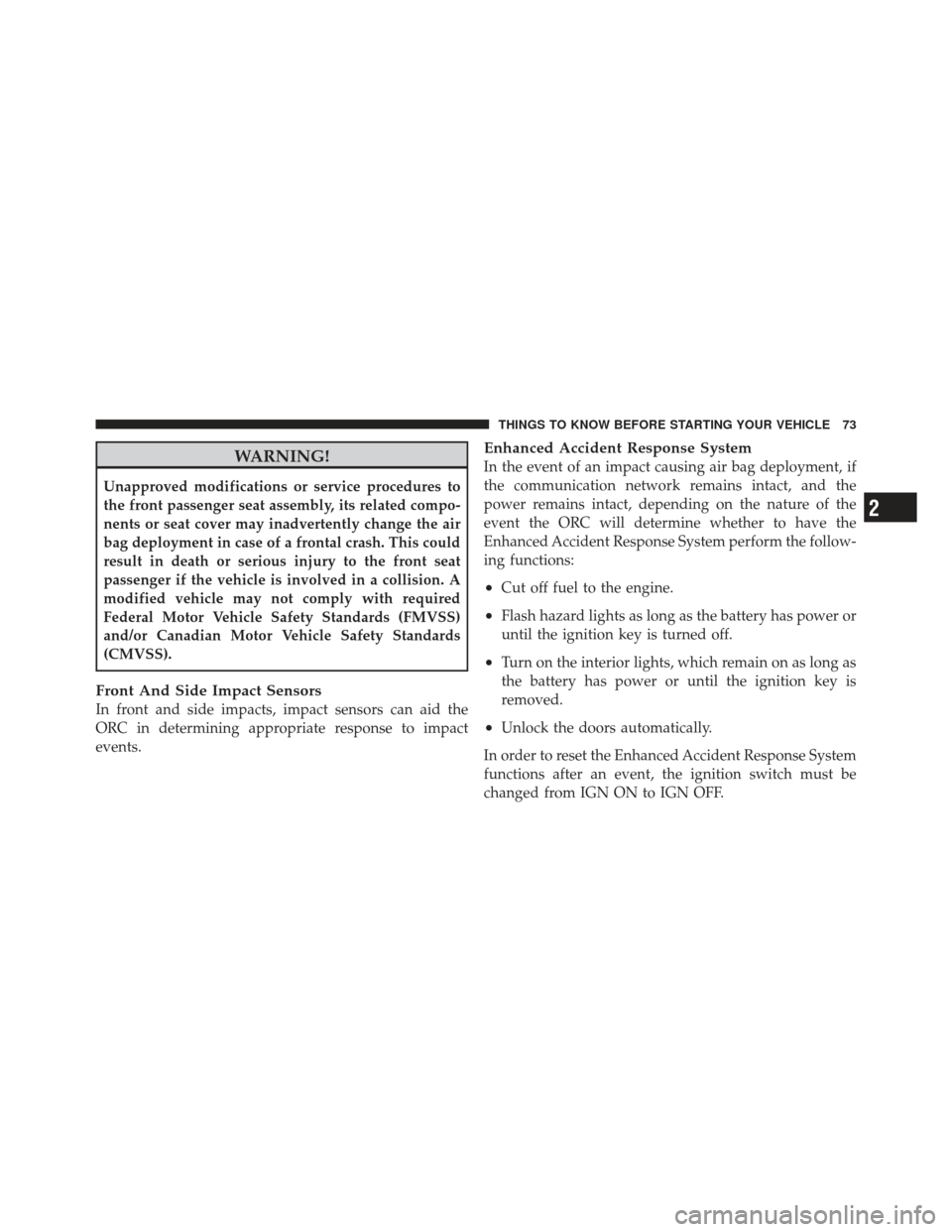
WARNING!
Unapproved modifications or service procedures to
the front passenger seat assembly, its related compo-
nents or seat cover may inadvertently change the air
bag deployment in case of a frontal crash. This could
result in death or serious injury to the front seat
passenger if the vehicle is involved in a collision. A
modified vehicle may not comply with required
Federal Motor Vehicle Safety Standards (FMVSS)
and/or Canadian Motor Vehicle Safety Standards
(CMVSS).
Front And Side Impact Sensors
In front and side impacts, impact sensors can aid the
ORC in determining appropriate response to impact
events.
Enhanced Accident Response System
In the event of an impact causing air bag deployment, if
the communication network remains intact, and the
power remains intact, depending on the nature of the
event the ORC will determine whether to have the
Enhanced Accident Response System perform the follow-
ing functions:
•Cut off fuel to the engine.
•Flash hazard lights as long as the battery has power or
until the ignition key is turned off.
•Turn on the interior lights, which remain on as long as
the battery has power or until the ignition key is
removed.
•Unlock the doors automatically.
In order to reset the Enhanced Accident Response System
functions after an event, the ignition switch must be
changed from IGN ON to IGN OFF.
2
THINGS TO KNOW BEFORE STARTING YOUR VEHICLE 73